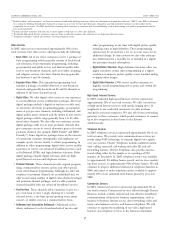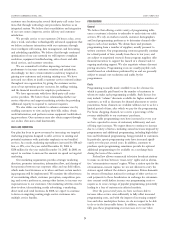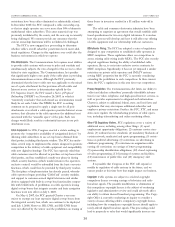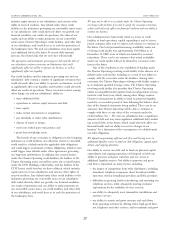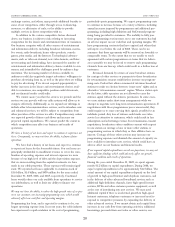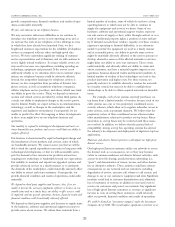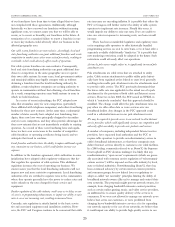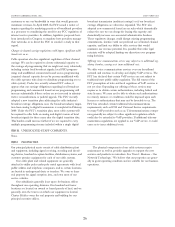Charter 2007 Annual Report Download - page 27
Download and view the complete annual report
Please find page 27 of the 2007 Charter annual report below. You can navigate through the pages in the report by either clicking on the pages listed below, or by using the keyword search tool below to find specific information within the annual report.
Telephone Service
The 1996 Telecom Act created a more favorable regulatory
environment for us to provide telecommunications services. In
particular, it limited the regulatory role of local franchising
authorities and established requirements ensuring that providers
of traditional telecommunications services can interconnect with
other telephone companies to provide competitive services.
Many implementation details remain unresolved, and there are
substantial regulatory changes being considered that could
impact, in both positive and negative ways, our primary telecom-
munications competitors and our own entry into the field of
telephone service. The FCC and state regulatory authorities are
considering, for example, whether common carrier regulation
traditionally applied to incumbent local exchange carriers should
be modified and whether any of those requirements should be
extended to VoIP providers. The FCC has already determined
that providers of telephone services using Internet Protocol
technology must comply with traditional 911 emergency service
opportunities (“E911”), requirements for accommodating law
enforcement wiretaps (CALEA), universal service fund collection,
and telephone relay requirements to VoIP providers. It is unclear
whether and how the FCC will apply additional types of
common carrier regulations, such as inter-carrier compensations
to alternative voice technology. In March 2007, a federal appeals
court affirmed the FCC’s decision concerning federal regulation
of certain VoIP services, but declined to find that VoIP service
provided by cable companies, such as we provide, should be
regulated only at the federal level. As a result, some states have
begun proceedings to subject cable VoIP services to state level
regulation. Also, the FCC and Congress continue to consider to
what extent, VoIP service will have interconnection rights with
telephone companies. It is unclear how these regulatory matters
ultimately will be resolved and how they will affect our potential
expansion into telephone service.
Employees
As of December 31, 2007, we had approximately 16,500 full-time
equivalent employees. At December 31, 2007, approximately 100
of our employees were represented by collective bargaining
agreements. We have never experienced a work stoppage.
ITEM 1A. RISK FACTORS.
Risks Related to Significant Indebtedness of Us and Our Subsidiaries
We and our subsidiaries have a significant amount of debt and may
incur significant additional debt, including secured debt, in the future,
which could adversely affect our financial health and our ability to
react to changes in our business.
We and our subsidiaries have a significant amount of debt and
may (subject to applicable restrictions in our debt instruments)
incur additional debt in the future. As of December 31, 2007, our
total debt was approximately $19.9 billion, our shareholders’
deficit was approximately $7.9 billion and the deficiency of
earnings to cover fixed charges for the year ended December 31,
2007 was $1.4 billion.
Because of our significant indebtedness and adverse changes
in the capital markets, our ability to raise additional capital at
reasonable rates, or at all, is uncertain, and the ability of our
subsidiaries to make distributions or payments to their parent
companies is subject to availability of funds and restrictions under
our subsidiaries’ applicable debt instruments and under applicable
law. If we need to raise additional capital through the issuance of
equity or find it necessary to engage in a recapitalization or other
similar transaction, our shareholders could suffer significant dilu-
tion, including potential loss of the entire value of their invest-
ment, and in the case of a recapitalization or other similar
transaction, our noteholders might not receive principal and
interest payments to which they are contractually entitled.
Our significant amount of debt could have other important
consequences. For example, the debt will or could:
krequire us to dedicate a significant portion of our cash flow
from operating activities to make payments on our debt,
reducing our funds available for working capital, capital
expenditures, and other general corporate expenses;
klimit our flexibility in planning for, or reacting to, changes in
our business, the cable and telecommunications industries,
and the economy at large;
kplace us at a disadvantage compared to our competitors that
have proportionately less debt;
kmake us vulnerable to interest rate increases, because net of
hedging transactions approximately 15% of our borrowings
are, and will continue to be, subject to variable rates of
interest;
kexpose us to increased interest expense to the extent we
refinance existing debt with higher cost debt;
kadversely affect our relationship with customers and
suppliers;
klimit our ability to borrow additional funds in the future, due
to applicable financial and restrictive covenants in our debt;
kmake it more difficult for us to satisfy our obligations to the
holders of our notes and for our subsidiaries to satisfy their
obligations to the lenders under their credit facilities and to
their noteholders; and
klimit future increases in the value, or cause a decline in the
value of our equity, which could limit our ability to raise
additional capital by issuing equity.
A default by one of our subsidiaries under its debt obliga-
tions could result in the acceleration of those obligations, which
in turn could trigger cross defaults under other agreements
governing our long-term indebtedness. In addition, the secured
lenders under the Charter Operating credit facilities, the holders
of the Charter Operating senior second-lien notes, the secured
lenders under the CCO Holdings credit facility, and the holders
of the CCH I notes could foreclose on their collateral, which
CHARTER COMMUNICATIONS, INC. 2007 FORM 10-K
16



